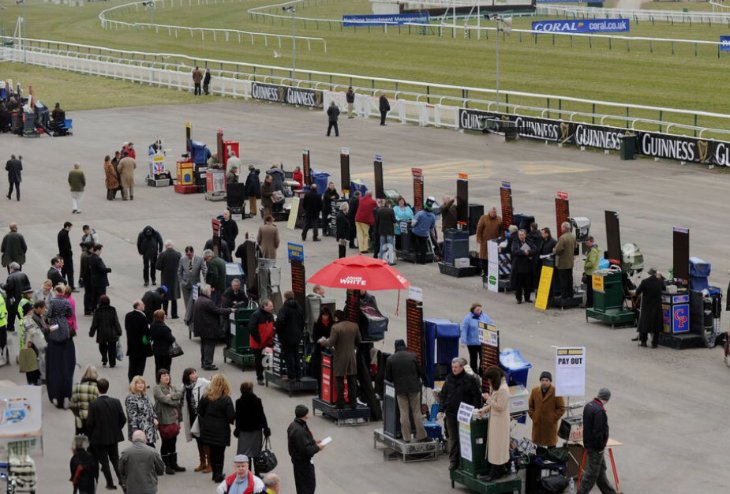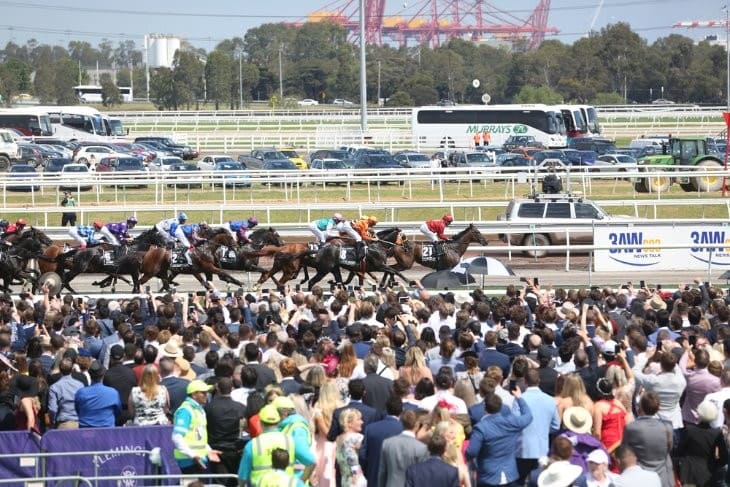We may live in the era of online betting, but many lovers of this beautiful sport still defy and insist on the unique atmosphere that comes with the betting ring. Simply, this is a traditional and integral part of horse racing culture, especially in countries with a strong history of horse racing like the United Kingdom, Ireland, Australia, and others. The betting ring remains a vibrant and engaging aspect of the horse racing experience. Lively and exciting atmosphere, with spectators interacting with bookmakers, studying from guides and race cards, and placing bets – a betting ring is a place where experienced bettors use their knowledge and instincts to make informed wagers, and where novices might place their first bets. It is an integral part of the history of horse racing.
History of the Betting Ring in Horse Racing
The origins and development of the betting ring in horse racing reflect the dynamic interplay between tradition and modernization. While the advent of technology has introduced new ways to place bets, the unique atmosphere and culture of the betting ring continue to hold significance for horse racing enthusiasts around the world.

Origins and Early Days:
The practice of horse racing and betting has ancient origins, dating back to civilizations like ancient Greece and Rome. Back in the day, chariot races and mounted contests were popular forms of entertainment, often accompanied by betting among spectators.
In these ancient cultures, individuals would wager on the prowess of horses and riders, which led to the first relatively organised forms of betting.
Emergence of Organised Horse Racing:
However, it took centuries before we saw the horse racing as we know it today. It began to take shape in mediaeval England. By the 12th century, there were already formalised racing events, with nobility and royalty often participating. Over time, these races transitioned from contests of endurance and utility to competitive events that drew public attention and participation.
By the 17th and 18th centuries, organised horse racing began to take a modern shape. For the first time, races became more formalised and structured. And because of that, the desire to place wagers on race outcomes grew. For the first time, we saw informal betting areas around racecourses. These areas were often marked by a ring of spectators and bookmakers who would offer odds and take bets, and that’s probably where the “betting ring” term comes from.
Development of Betting Stands:
As horse racing was becoming more popular it became a more regulated sport as well. The betting areas became more structured and organised. We saw betting stands or booths and bookmakers, who were responsible for setting odds and taking bets, began to establish themselves in these betting stands. They became responsible for calling out odds and interacting with bettors, so we could say these were the early days of the interactive and lively atmosphere we know today.
Betting stands were designed with both bookmakers and bettors in mind. They often featured individual booths or counters where bookmakers could display odds and interact with customers. Over the years we saw an improvement in betting stand design, all in order to ensure an efficient flow of foot traffic and provide clear visibility of odds and information.
Spread of Betting Culture:
In colonial times, horse racing and betting on races started to spread to various parts of the world as European powers expanded their influence. Soon after, we saw new horse racing traditions and betting practices around the world. Meanwhile, in the UK, horse betting was becoming more and more ingrained in the culture.
This was the era when major events like Royal Ascot and the Grand National were established and gained widespread attention.
Rise of Professional Bookmakers:
Logically, this led to the rise of professional bookmakers, which represents one of the most important chapters in the history of betting rings and horse racing. These individuals played a crucial role in shaping the modern betting landscape and establishing the framework for wagering on horse races.
The rise of professional bookmakers marked a significant shift in the betting landscape. They transformed horse race wagering from an informal pastime into a structured and regulated industry. Professional bookmakers shaped the culture and atmosphere of the betting ring, while also contributing to the development of odds-setting practices and betting traditions that continue to influence horse racing today.
Transition to Specialisation:
The emergence of professional bookmakers brought a shift from casual wagering to a more structured and systematic approach. They specialised in setting odds, accepting bets, and managing wagering activities, which raised the overall betting experience to a much higher level.
Simply, bookmakers became skilled at assessing the strengths and weaknesses of horses, jockeys, trainers, and other factors that could influence race outcomes. And that kind of expertise allowed to set odds that reflected the perceived likelihood of different horses winning, probably for the first time in betting history.
Central Role in Betting Ring:
Betting rings started getting the modern shape we know today. Professional bookmakers would set up stands or booths within the betting ring at racecourses. Soon enough, these stands became central hubs for bettors to place their wagers, with bookmakers' calls of odds and interactions with bettors creating a lively and engaging atmosphere.
And with the desire to provide a unique betting experience, many bookmakers developed unique personalities and distinctive methods of attracting attention. Their calls, antics, and colourful language made the betting ring what it is today.
Setting Odds and Balancing Books:
Of course, this was one of the main tasks of bookmakers. They were responsible for setting the odds for each horse in a race and these odds reflected the bookmakers' assessment of the horse's chances of winning. Bookmakers started considering factors like recent form, track conditions, jockey performance, and more.
But bookmakers also aimed to balance their books by ensuring that they had a roughly equal amount of money wagered on each horse. In that way, they minimise their risk and ensured that they could pay out winnings to successful bettors.
Evolution of Betting Technology:
The rise of professional bookmakers is closely related to advances in technology. For example, the introduction of the telegraph enabled bookmakers to receive up-to-date information about races and adjust their odds accordingly.
Then the telephone came, which allowed bookmakers to expand their service and reach more bettors. For example, bettors started placing wagers remotely, which was a pretty revolutionary thing back in the day.
Regulation and Modernization:
As horse racing became more regulated and formalised, bookmakers faced increasing scrutiny and regulation from racing authorities. Authorities started practising issuing specific licences, while oversight also became a common way to ensure fair and transparent betting practices.
The next radical change came with the introduction of digital technology and online betting platforms. This has transformed the betting industry completely, so much that it challenged traditional bookmaking practices, including the betting ring. So, there is no other way to survive but to incorporate modern amenities while preserving the culture of the betting ring.
Influence of Technology and Regulation:
The 20th century brought advancements in technology, such as telecommunication and later the internet, as we already mentioned. The way bets were placed changed significantly, with the introduction of off-track betting and online betting platforms.
Of course, this also required regulatory changes and modernization efforts. All these things affected the operations of the betting ring. Some traditional racetracks even introduced digital betting terminals alongside the traditional betting ring to cater to modern preferences.
Culture and Atmosphere:
The history of the betting ring from the perspective of culture and atmosphere is rich and fascinating. Simply, there aren’t many things that played such a significant role in shaping the horse racing experience, making a unique social environment. The history of the betting ring in horse racing from a cultural and atmospheric perspective highlights its role as a vibrant social space, where generations of horse racing enthusiasts have come together to share their passion, knowledge, and excitement. Even today, in this virtual era, the betting ring continues to be a place where the traditions of the past blend with the innovations of the present, creating a dynamic and engaging experience for all involved.
Vibrant Gathering Place:
The betting ring has historically served as a central gathering place for horse racing enthusiasts, both seasoned bettors and casual spectators. It's a place where people with a shared passion for horse racing come together to engage in discussions, share tips, and exchange insights.
The lively and bustling nature of the betting ring creates an energetic atmosphere that contributes significantly to the overall excitement of race day. The sounds of bookmakers calling out odds, the hum of conversations, and the anticipation of upcoming races – this is what makes horse betting a unique experience.
Social Interaction and Community:
Above all, the sense of community among horse racing fans is what makes betting rings special. People from various backgrounds come together to engage in friendly banter, discuss their favourite horses, and share their predictions.
Experienced bettors often share their expertise with newcomers, offering advice on betting strategies and insights into the form of the horses. This exchange of knowledge is also one of the specifics of horse betting.
Global Variations
Each region brings its own cultural traditions and customs to the betting ring. Local practices, superstitions, and betting rituals may vary, adding to the unique character of each betting ring.
So, global variations in the betting ring concept within horse racing reflect the diverse ways in which different cultures engage with the sport and wagering. While the core idea of a central place for bookmakers and bettors remains consistent, each region brings specific arrangements and cultural influences to create distinct and richly varied experiences.
United Kingdom and Ireland:
The UK and Ireland have a rich tradition of horse racing and betting. It’s where everything began. The betting ring at British and Irish racecourses is famous for lively interactions between bookmakers and bettors. Also famous are bookmakers with their unique pitches, passed down through generations.
In the UK, bookmakers at the racecourse often belong to a collective known as the "Rails Bookmakers," who operate from designated areas along the rails of the racetrack. But, there are also "Tattersalls" bookmakers who operate in a separate enclosure.
Things are pretty similar in Ireland, where bookmakers also offer odds and take bets in designated areas while betting rings in both countries contribute to the vibrant social atmosphere of race days.
Australia and New Zealand:
Betting on horse racing is deeply ingrained in the cultures of Australia and New Zealand. The betting ring in these countries often features bookmakers who offer odds and take bets on both local and international races. The atmosphere in the Australian and New Zealand betting rings can be lively and engaging, with bookmakers often engaging in friendly banter with bettors.
All in all, it’s hard to find any substantial difference compared to betting rings in the UK and Ireland.
United States:
On the other hand, things vary a lot in the United States, due to different approaches to horse racing and betting, as well as different state regulations. While there may not be a uniform betting ring concept across all tracks, some tracks do have designated areas where bookmakers or "bookies" set up to take bets.
Unfortunately or not, betting in the United States is much more about off-track betting, online betting and licenced sportsbooks.
Asia:
Some Asian countries also have a strong horse racing tradition, such as Japan and Hong Kong, and the culture of betting on races is prevalent. Betting may be facilitated through dedicated areas or booths at racetracks, but the betting experience in Asian countries is also influenced by cultural factors and local customs.
Online Betting and Other Challenges

The betting landscape is constantly changing and, therefore, brings all kinds of challenges to traditional forms like betting rings. These challenges have prompted the betting industry to adapt in order to preserve the unique culture and atmosphere of the traditional betting ring.
- Online Betting Platforms: One of the most significant challenges to the traditional betting ring is the rapid growth of online betting platforms. Bettors can now place wagers from the comfort of their homes or mobile devices, bypassing the need to visit the physical racetrack and the traditional betting ring. The convenience, ease of use, and availability of a wide range of races from around the world on online platforms have attracted a new generation of bettors who prefer the digital experience.
- Decline in Foot Traffic: As more bettors opt for online betting, the traditional betting ring at racetracks has seen a decline in foot traffic. This reduction in in-person wagering activity can affect the lively and social atmosphere that has been a hallmark of the betting ring.
- Preservation of Atmosphere: The traditional betting ring is known for its vibrant and interactive atmosphere, with bookmakers calling out odds, bettors discussing tips, and the excitement of race day palpable in the air. The challenge lies in preserving this unique ambience in the face of changing preferences and technology.
- Competition from Other Forms of Gambling: The betting ring faces competition from other forms of gambling, such as casinos, sports betting, and online gaming. All these alternative gambling options offer diverse entertainment experiences and can divert attention and spending away from horse racing.
- Generation Gap and Modernization: New generations have different preferences. Traditional betting ring culture may be more appealing to older generations who appreciate the social aspect and nostalgic charm. Younger generations, on the other hand, may find the in-person betting ring less attractive and less convenient.
- Regulatory Challenges: The changing landscape of betting, including the rise of online platforms, has prompted regulatory adjustments. Authorities must navigate new regulations to ensure fair play, protect consumers, and maintain the integrity of horse racing.
- Balancing Tradition and Innovation: The challenge lies in striking a balance between preserving the traditional betting ring's unique culture and atmosphere while embracing technological innovations to remain relevant in these modern times.
- Hybrid Approaches: Some racetracks and betting operators are exploring hybrid approaches that combine elements of both traditional and modern betting. For example, there are digital betting terminals within the traditional betting ring or creating interactive experiences that bridge the gap between in-person and online wagering.
Summary
The betting ring in horse racing has a rich history that mirrors the evolution of the sport and the human fascination with wagering. It started with informal betting areas, but the concept developed into structured betting stands where professional bookmakers set odds and engaged with bettors. This created a unique, vibrant culture, characterised by social interaction, traditions, and a unique atmosphere at racetracks. But, modern forms like online betting, regulatory changes, and competition from other forms of gambling bring new challenges, which will undoubtedly have a big impact on the ever-changing landscape of betting rings and horse betting in general.








